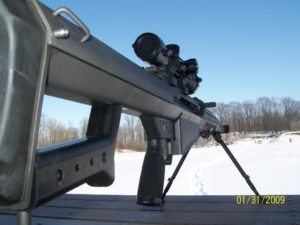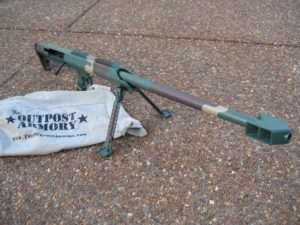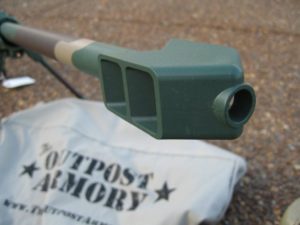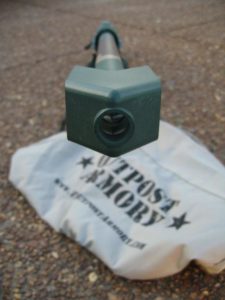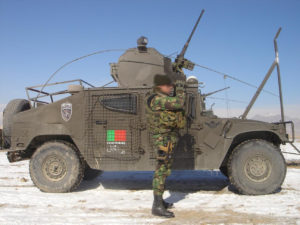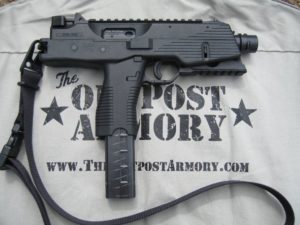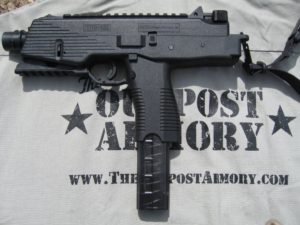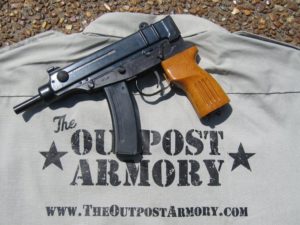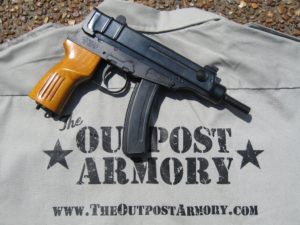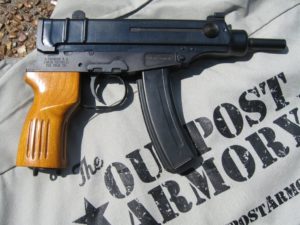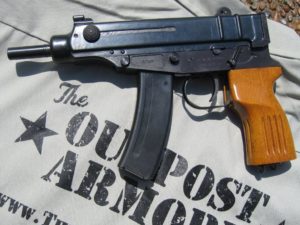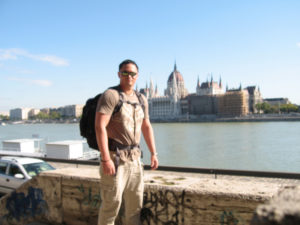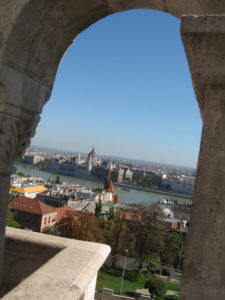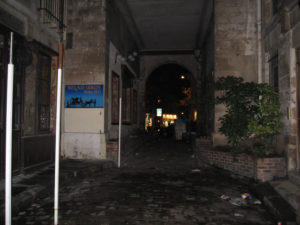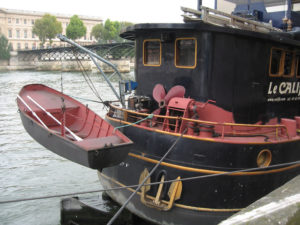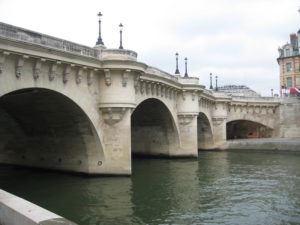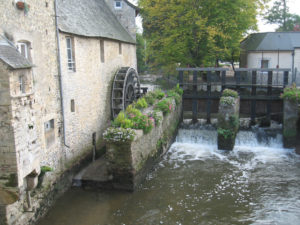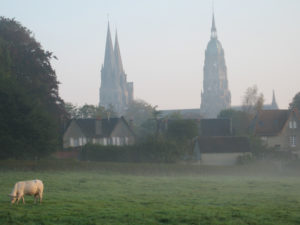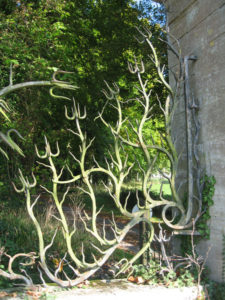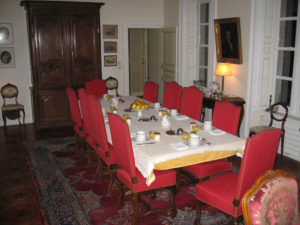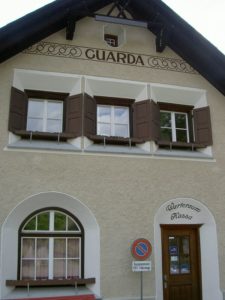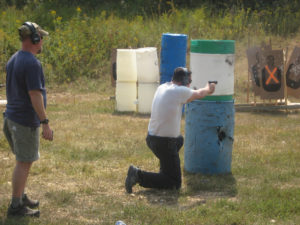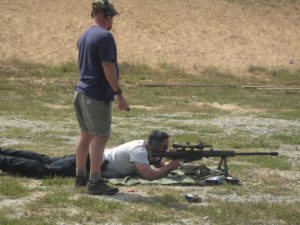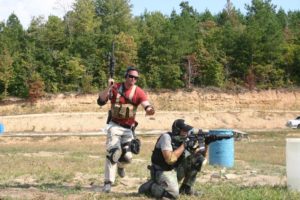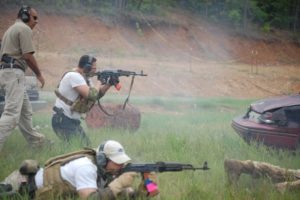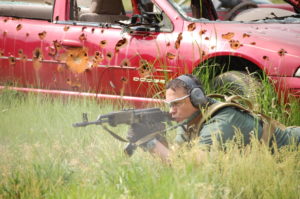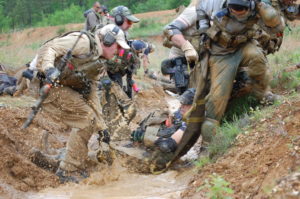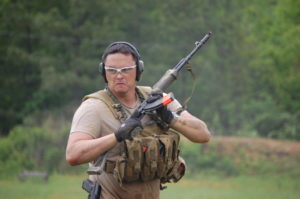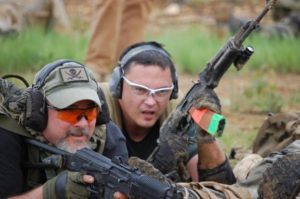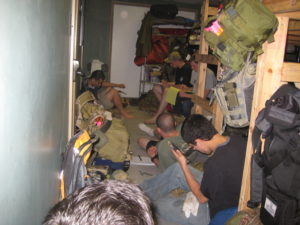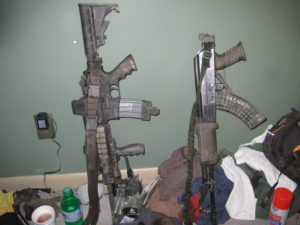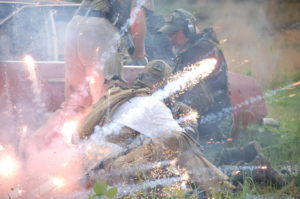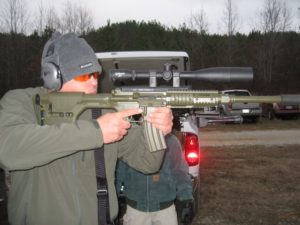The Gray Man World
Enemies
The Enemies of the Gray Man
OPEN SOURCE INTELLIGENCE
Each of the organizations listed is an actual intelligence, law enforcement, or paramilitary organization in existence today. They all are mentioned in the Gray Man. The accompanying articles are culled from open-source documents on the internet, and no implication should be made as to their veracity.
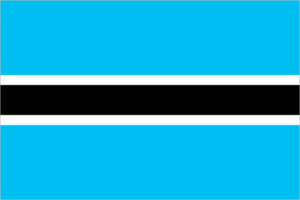 Directorate on Intelligence and Security Services (DISS)
Directorate on Intelligence and Security Services (DISS)
Police receive reports of DIS torture
30 March, 2009 in Botswana
source: Mmegi
ISAIAH MOREWAGAE
Staff Writer
27 March 2009
The police have received three reports alleging abuse by the Directorate of Intelligence and Security (DIS). The Minister of Justice, Defence and Security, Dikgakgamatso Seretse told Parliament yesterday that one report is from a police officer, while two are from civilians. Seretse was answering questions from the Member of Parliament for Gaborone Central, Dumelang Saleshando. The minister said a DIS operative was killed by his pistol during a shoot-out with thugs. “Investigations on this matter are still on-going therefore, I am not in a position to disclose any information,” Seretse said. A Zimbabwean, Blessing Mukweni is currently in court on allegations that he shot and killed DIS officer, Daniel Moilwa in Gaborone on November 19 last year.
Since its inception early last year, the DIS has dominated news headlines for the wrong reasons. Four members of the security forces claimed torture at the
The Minister of Justice, Defence and Security, Dikgakgamatso Seretse told Parliament yesterday that one report is from a police officer, while two are from civilians. Seretse was answering questions from the Member of Parliament for Gaborone Central, Dumelang Saleshando. The minister said a DIS operative was killed by his pistol during a shoot-out with thugs. “Investigations on this matter are still on-going therefore, I am not in a position to disclose any information,” Seretse said. A Zimbabwean, Blessing Mukweni is currently in court on allegations that he shot and killed DIS officer, Daniel Moilwa in Gaborone on November 19 last year.
Since its inception early last year, the DIS has dominated news headlines for the wrong reasons. Four members of the security forces claimed torture at the hands of DIS agents late last year. Two soldiers and two policemen alleged that they were severely beaten and humiliated in a torture chamber at the offices of DIS in Gaborone in October last year.
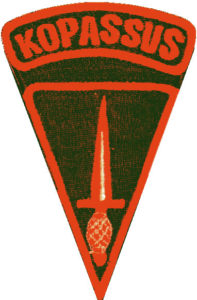 Kopassus Command Group IV
Kopassus Command Group IV
Kopassus, abbreviation for Komando Pasukan Khusus (Army Special Force Command) is an Indonesian Army special forces group that conducts special operations missions for the Indonesian government, such as direct action, unconventional warfare, sabotage, counter-terrorism, and intelligence gathering.
Training Members of the Kopassus are selected from other units for their mental and physical toughness and ideological soundness. Those who pass an initial screening take part in a 9-month selection, with heavy emphasis on physical endurance. At the end of this phase, a 380-km march is conducted through mountainous terrain with minimal rations. Then a week-long evasion and escape phase is conducted; if caught, one is removed from the program. As manpower is increased to meet a three- and four-part rotational cycle, additional training would be expected. Also, as units have been used fairly extensively throughout the years, many of the Kopassus members have actual mission experience.This training is the qualification for new members to join Kopassus. After joining Kopassus there is still more advanced training, divided into two categories:
- Intelligence Gathering Abilities
- Counter Terrorism Unit
During the 1990s Kopassus conducted training with various other special forces, such as the British SAS (Special Air Service Regiment), the Malaysian Grup Gerak Khas in jungle warfare, urban terrain and counter terrorism skills, the American Delta Force in counter terrorism skills, and the American Green Berets in jungle warfare and training the local communities to conduct intelligence-gathering and to provide support. Kopassus and the Malaysian Grup Gerak Khas (GGK) enjoy a close relationship and both train extensively together.
Intelligence abilities In Kopassus, intelligence is taught after members have passed the selection process. The syllabus in intelligence can be sub-divided into two categories: Sandi Yudha, and gathering intelligence behind enemy lines, of which Sandy Yudha is considered the more specialized. Sandy Yudha is defined as the ability to persuade people to do something, and the ability to create exploitable situations.During the 1980s, Kopassus troops improved their skills in intelligence gathering by cross training with world famous intelligence services, such as the Israeli Mossad[citation needed], even though Indonesia does not have diplomatic relations with Israel. With the help of third parties, it became possible to conduct this training in Indonesia. The nickname for the trainer was “Arizona”. After Arizona finished the training of Kopassus, the British were invited, with their MI6[citation needed]. The training specialized in the effective and efficient use of intelligence gathering devices.
Types of arms used by Kopassus
- Side arm: SIG-Sauer P226/P228, Berreta 92SB/92F, Browning HP, Walther PPK, Pindad P1/2, Glock 17, Glock 19, FN Five-Seven
- Submachine gun: Heckler & Koch MP5 variants, CZ-Scorpion, Uzi, Daewoo K-7, FN P90.
- Assault rifle: Pindad SS2, Pindad SS1 variants, AK47, Steyr Aug A1/A2, M16A2, M4A1, H&K HK53, H&K 416, SIG 552, H&K G36C, Galil .
- Shotgun: Franchi SPAS-12, Benelli M3T.
- Sniper Rifle: Pindad SPR-1, Sig-Sauer SG550, H&K MSG 90, H&K G3 Sniper, Galil Sniper, Remington 700, Accuracy International AWM.
- Machine gun: FN Minimi, Ultimax 100, Daewoo K-3 LMG, FN MAG, and M60
- Recoilless rifle : Armbrust, Carl Gustav recoilless rifle
- Water devices : Drager, Spero, Oxydive, Farallon, Rubber (Zodiac type) boats
- Knife : Kopassus black Fairbairn-Sykes made by Carl Schlieper Germany
Human rights issues Kopassus has been accused of a great number of human rights violations. Its name appears frequently in the reports of Amnesty International and other international human rights organizations, as well as in the reports by Indonesian human rights groups. Kopassus members are frequently accused of assault. For example, Koes Sofyan of the Association of Human Rights Victims Abuse (SPKP HAM) was in 2003 detained by members of Kopassus in Aceh. He was detained for nearly three months and tortured, before being released without charge. Such charges were already made in the years of the Suharto dictatorship, though making them then in Indonesia itself was difficult and quite risky. In November 2001 Kopassus killed Theys Eluay, the chairman of the Presidum Dewan Papua. Two years later four Kopassus members were convicted for this murder. Kopassus has also been associated with illegal economic activities, like involvement in the trade of kayu gaharu and illegal gold mining in West Papua and other areas, and the trade in drugs.
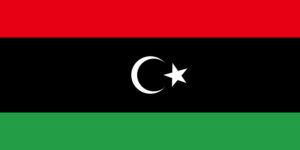 Jamahiriya Security Organization
Jamahiriya Security Organization
Haiat amn al Jamahiriya
Jamahiriya Security Organization (JSO)[aka External Security Organization (ESO)][aka Libyan Intelligence Service (LIS)]
The Libyan External Security Organization, a/k/a Jamahiriya Security Organization (hereinafter “JSO”) is an intelligence and operational entity which operates separately from, but is an agency, instrumentality and/or organ of the Libyan government.
This service is divided into two branches: Internal Security, and Foreign Security. This organization has several branches, amongst which: Foreign Liaison Office, which has overall responsibility for most overseas intelligence operations and a sub-directorate provides direct contact with international terrorist groups.
- Foreign Security Special Operations,
- External Security (including External Operations and Fundamentalist Movements)
The Libyan External Security Organization (ESO) is the principal intelligence institution in Libya which has been responsible for supporting terrorist organizations and for perpetrating state sponsored acts of terrorism
In November 2001 Abdallah Senussi, the deputy head of Libyan intelligence who was implicated in the bombing of a French airliner in 1989, was put under house arrest. Abdallah Senussi, who is Libyan leader Moamer Kadhafi’s brother-in-law, was put under house arrest along with several other Libyan intelligence officials. Senussi had been a Kadhafi confidant for 20 years. Senussi, along with five Libyan agents and diplomats, was condemned in absentia to life in prison by a Paris court in March 1999 for his involvement in the bombing of a French UTA airliner over Nigeria in 1989, killing 170 people.
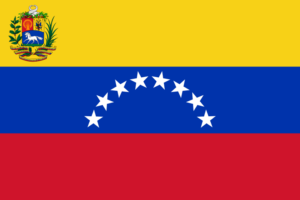 General Intelligence Office
General Intelligence Office
The New York Times June 3, 2008 Tuesday Late Edition – Final
CHAVEZ DECREE TIGHTENS HOLD ON INTELLIGENCE
BYLINE: By SIMON ROMERO
SECTION: Section A; Column 0; Foreign Desk; Pg. 1
LENGTH: 1127 words
DATELINE: CARACAS, Venezuela
President Hugo Chavez has used his decree powers to carry out a major overhaul of this country’s intelligence agencies, provoking a fierce backlash here from human rights groups and legal scholars who say the measures will force citizens to inform on one another to avoid prison terms.
Under the new intelligence law, which took effect last week, Venezuela’s two main intelligence services, the DISIP secret police and the DIM military intelligence agency, will be replaced with new agencies, the General Intelligence Office and General Counterintelligence Office, under the control of Mr. Chavez.
The new law requires people in the country to comply with requests to assist the agencies, secret police or community activist groups loyal to Mr. Chavez. Refusal can result in prison terms of two to four years for most people and four to six years for government employees.
”We are before a set of measures that are a threat to all of us,” said Blanca Rosa Marmol de Leon, a justice on Venezuela’s top court, in a rare public judicial dissent. ”I have an obligation to say this, as a citizen and a judge. This is a step toward the creation of a society of informers.”
The sweeping intelligence changes reflect an effort by Mr. Chavez to assert greater control over public institutions in the face of political challenges following a stinging defeat in December of a package of constitutional changes that would have expanded his powers.
Mr. Chavez, who has insisted the defeat will not dampen his ambitions to transform Venezuela into a Socialist state, said the new law was intended to guarantee ”national security” and shield against ”imperialist attacks.”
He lashed out at its critics as being agents of the ”empire,” meaning the United States.
The law’s stated aim of protecting Venezuela follows a history of antagonism between the governments in Caracas and Washington, dating at least from the Bush administration’s tacit support for a short-lived coup against Mr. Chavez in 2002.
Recently, Venezuela has claimed it was subject to military intimidation from the United States, pointing to a recent violation of Venezuelan airspace by an American fighter jet and Washington’s recent reactivation of its Fourth Fleet to patrol Latin American and Caribbean waters.
On Sunday, Mr. Chavez referred to critics of the intelligence law as de facto supporters of the Bush administration and of the Patriot Act, the American antiterrorism law that enhances the ability of security agencies to monitor personal telephone and e-mail communications.
Mr. Chavez’s new intelligence law has similar flourishes. For instance, it authorizes his new intelligence agencies to use ”any special or technically designed method” to intercept and obtain information.
But the new law may also point to the influence of Cuba, Venezuela’s top ally, on intelligence policies. For instance, the use of community-monitoring groups to assist in gathering intelligence resembles Cuba’s use of neighborhood Committees for the Defense of the Revolution to report on antigovernment behavior.
”This is purely Cuban-style policy,” Juan Jose Molina, a legislator with Podemos, a leftist party that broke from Mr. Chavez’s coalition last year, said of the new intelligence law. ”Our rulers want to impose old models upon us.”
Interior Minister Ramon Rodriguez Chacin announced the intelligence overhaul in a public appearance here last week, saying it was needed to combat ”interference from the United States” by having intelligence agency workers imbued with ”ideological commitment.”
On Monday, however, Mr. Rodriguez Chacin softened his tone, saying the law would not lead to political intimidation or restrict freedom of expression. ”We are talking about the responsibility all Venezuelans have with the security of the state and the resolution of any crime,” he said.
The drafting and passage of the law behind closed doors, without exposing it to the public debate it would have had if Mr. Chavez had submitted it to the Assembly, also contributed to the public uproar and suspicion.
One part of the law, which explicitly requires judges and prosecutors to cooperate with the intelligence services, has generated substantial concern among legal experts and rights groups, which were already alarmed by the deterioration of judicial independence under Mr. Chavez.
While the language of this passage of the law, and several others, is vague, legal experts say the idea is clear: justice officials, including judges, are required to actively collaborate with the intelligence services rather than serve as a check on them.
”This is a government that simply doesn’t believe in the separation of powers,” said Jose Miguel Vivanco, Americas director for Human Rights Watch, the New York-based rights organization. ”Here you have the president legislating by decree that the country’s judges must serve as spies for the government.”
Mr. Chavez’s opponents here grasped for reasons as to why he chose this moment for the intelligence overhaul, with his government grappling with economic problems like climbing inflation and slowing economic growth even as the price of oil, the lifeblood of Venezuela’s economy, remains near record levels.
”Even within the Bolivarian movement, this would officialize Soviet- and Cuban-style purges, accusing dissidents of being spies, traitors or agents of the imperialist enemy,” El Nacional, a normally staid opposition newspaper, said in an editorial that ended, ”This is revolting.”
In some ways, the changes would merely refine the control Mr. Chavez already exerts over intelligence operations. His government has already used voter registration data to purge employees deemed disloyal to the president from the intelligence agencies and other parts of the civil service.
Several legal activists said Monday that they were studying ways to appeal the law, but the viability of a legal challenge remains unclear.
”This is the most scandalous effort to intimidate the population in the 10 years this government has been in power,” said Rocio San Miguel, a prominent legal scholar who heads a nongovernmental organization that monitors Venezuelan security and defense issues.
Ms. San Miguel said information her group had collected could be deemed illegal under the new law. The group has data from military sources showing that Mr. Chavez’s efforts to create a force of one million reservists had fallen far short.
”Under the new law, this information could be considered a threat to national security and I could be sent immediately to jail,” she said. ”Effectively this is a way to instill fear in NGOs and news organizations and parts of society that remain outside the government’s reach.”
 National Intelligence Agency
National Intelligence Agency
Africa News
October 18, 2008 Saturday
South Africa; ANC Dissident Says Spies at Work
BYLINE: Cape Argus
LENGTH: 796 words
Mosiuoa Lekota is convinced he’s being spied on – despite denials by the National Intelligence Agency this week that it put a tail on the former defence minister and breakaway rebel.
As Lekota prepared to head for Bloemfontein to address tomorrow’s rally of supporters for his planned national convention in two weeks’ time, he spoke of a mysterious car which had followed him as he headed to Sandton for his first explosive press conference 10 days ago.
Last Thursday, his bodyguard, Sello Mptyaatona, was kidnapped and robbed by armed men – who delivered a chilling message that Lekota and his former deputy and fellow conventionist, Mluleki George, are treating as a death threat.
“Before my bodyguard was kidnapped we were being trailed by mysterious people in a car with false number plates,” Lekota said.
“My bodyguard is a police person. He took the [registration] number of that vehicle to the police, and when they checked they found that those number plates had been tampered with – they found that that make of car could not have had those number plates.
“A day later my bodyguard was kidnapped – and then given a message to convey to me: don’t go on with your political activity because you will continue with it in heaven.
“This is concrete evidence. It is clear that whoever kidnapped my bodyguard was busy with an operation that is not legal.”
Lekota’s bodyguard escaped with his life, unlike Captain Francois Ramashile, the man who helped to protect former president Thabo Mbeki but was shot dead while asleep next to his wife at home in his Pretoria bedroom last month. The shooting took place just three days before Mbeki’s recall by the ANC – an action that triggered the cascade of political events that have left South Africans reeling.
Now the police are saying they are not ruling out the possibility that the father-of-three was assassinated.
Superintendent Vish Naidoo told the Saturday Star: “The investigation is still continuing and it can be confirmed that nothing was taken [from the house]. We don’t know the motives and can’t rule out anything.”
Intelligence Minister Siyabonga Cwele was however clear about Lekota’s spying concerns: he has looked into the allegations and found no evidence of any unlawful operation by the National Intelligence Agency.
His spokesperson, Lorna Daniels, this week said while it wasn’t policy to confirm or deny NIA operations, “we do think it is important to reassure citizens that we are not concerned with legitimate political activity.
“Only those engaged in unlawful activity receive the NIA’s attention,” she said. Lekota’s activities were “legitimate”.
Daniels would not comment on the possibility that Lekota was the target of a private spying operation mounted by people unhappy with his plans to launch a new party that may challenge the ANC at the ballot box.
That initiative was boosted this week when former Gauteng premier Mbhazima Shilowa climbed aboard as convener and “volunteer-in-chief” – although his main job will be to raise funds.
Shilowa’s announcement that he was abandoning the ANC unleashed a stream of invective from the union movement he helped build – and fulfilled his prediction at his press conference when he said he expected to be vilified.
Cosatu general secretary Zwelinzima Vavi told the Saturday Star that Shilowa’s ambition had seen him change from being “a son of the workers” and an ardent socialist “who wore red socks with pride” to a cigar-smoking wealthy businessman with “disappointed political ambitions”.
“No one pushed him from the position of premier – he sidelined himself,” Vavi said. “He can only ascend to power [again] if he can bring the poor to vote.”
As the ANC’s national executive committee deliberated for hours behind closed doors in a specially convened meeting to decide what to do about the rebels in its ranks, NEC member Charlotte Lobe announced that she, too, was joining Lekota.
The same evening, ANC president Jacob Zuma addressed the nation on SABC TV and all the state broadcasters’ radio stations, conceding that the ANC was losing leaders but insisting this did not mean it was under threat or that there was a 50-50 split.
Zuma defended the decision by the ANC’s national working committee on Monday to summarily suspend Lekota and George, saying no organisation could “just stand by when people use it to undermine it, or even attempt to destroy it”.
Announcing its decision to haul Lekota and George before a disciplinary committee, the NEC acknowledged that plans for a party in opposition to the ANC was “a challenge” – and spelt out its plans to contain the threatened revolt, including sending NEC members into the regions to try “to heal whatever divisions may exist and repair whatever hurt may have been done”. – Additional reporting by Sheree Bega
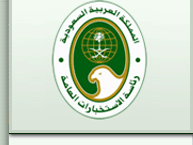 Al Mukhabarat Al A’amah
Al Mukhabarat Al A’amah
BBC Monitoring Trans Caucasus Unit
Supplied by BBC Worldwide Monitoring
December 8, 2008 Monday
Saudi Arabia “behind Jondollah hostage taking”
LENGTH: 456 words
Text of report in English by Iranian news channel Press TV website on 8 December
A report reveals Saudi Arabian intelligence agencies were behind the abduction of a group of Iranian police officers by Jondollah.
Sixteen Iranian police officers were abducted by Jondollah [Soldiers of God] terrorists at a checkpoint in the southeastern city of Saravan in Iran’s Sistan-Baluchestan Province on June 12.
The armed insurgents initially threatened to kill the hostages unless 200 of its members are released from Iranian prisons.
The cell killed three of the hostages in June. The Arabic-language TV channel al-Arabiya aired footage of the execution of the Iranian hostages.
After Iran refused to heed their warning, the terrorist group killed the remaining thirteen hostages on December 3.
Iran’s Prosecutor General Qorban Ali Dorri-Najafabadi has warned that Iranian forces will deliver a “crushing response” to the militants in border areas.
The Arabic Nahrainnet website cited informed sources in Pakistan’s Peshawar on Monday who claimed that Saudi Arabian intelligence agencies have significantly increased the number of their covert operations.
The sources also reported that Saudi Arabia has extended its channels of communication across Pakistan and particularly Peshawar over the past three months.
According to information obtained from sources in Peshawar, Saudi Arabia has been directly supporting Jondollah to carry out the hostage taking of Iranian police officers.
The report claims Saudi Arabia and the US Central Intelligence Agency (CIA) have been using the “proxy army” to destabilize the government in Iran.
Earlier in July, Pakistan’s former Army Chief, Retired General Mirza Aslam Baig, said the outlawed group is the main recipient of US financial and military aid.
Baig said Washington has been providing Jondollah with training facilities to fuel unrest in the area and strain Tehran-Islamabad relations.
ABC News, in 2007, cited US and Pakistani intelligence sources that the group, which “has taken responsibility for the deaths and kidnappings of Iranian soldiers and officials”, “has been secretly encouraged and advised by American officials.”
In another report in July, investigative journalist Seymour Hersh revealed that US Congressional leaders secretly agreed last year to President George W. Bush’s $400-million funding request for a major escalation in covert operations in Iran.
Under the ruling, the US can arm and fund terrorist groups such as the Mojahedin-e Khalq Organization [MKO] and Jondollah militants.
The group’s ringleader Abdolmalek Rigi describes his terrorist cell as a ‘national movement’ and denies any links to Washington.
Source: Press TV website, Tehran, in English 1529 gmt 8 Dec 08
Pictured- Logo of the Saudi Arabian General Intelligence Presidency
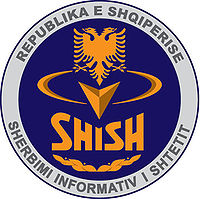 SHISH State Intelligence Service
SHISH State Intelligence Service
The State Intelligence Service, commonly known by its acronym SHISH, is the primary intelligence agency of Albania. It was created in 1991 by the Albanian Peoples Assembly as SHIK, acronym of Shërbimi Informativ Kombëtar (National Intelligence Service), but it later changed it`s name in SHISH. The agency has been used to manage internal dissent and protect the interests of the individual members of the regime.On April 1, 1997, Bashkim Fino announced that SHIK activity would be suspended effective from March 31. SHIK Director Bashkim Gazidede and his deputy, Bujar Rama, resigned. On May 30, the President, named Arben Karkini as the new head of SHIK. He was succeeded by Fatos Klosi after the Socialists won the July 1997 parliamentary elections. In October 1997, the United States Central Intelligence Agency sent a team of experts to assist the government in restructuring the SHIK. In November 1999, SHIK was renamed SHISH. The actual direcor is Bahri Shaqiri.
Mission and Function The State Intelligence Service has the following duties:
- collect information from abroad for the purposes of national security;
- undertake intelligence activity for purposes of the protection of integrity, independence and constitutional order;
- collect information in regard to terrorist activity, production and trafficking of narcotics, in regard to production of weapons of mass destruction as well as crimes against the environment.
- collect information in regard to organized crime that endangers the national security.
Relationship with other state entities Institutional Position of the State Intelligence Service and relationship with other state bodies:The State Intelligence Service is under the authority of the Prime Minister. Its Head is appointed and dismissed by the President of the Republic with the proposal of the Prime Minister.SHISH is operating within this context and while it has been identified as being “generally under effective civilian control” (U.S. Department of State, 2004) the agency has still been associated with various abuses within the country and continues to play a significant role in domestic politics. While the Albanian government has received support from the U.S. and European countries in working to establish or reform national institutions including it’s intelligence and security services.
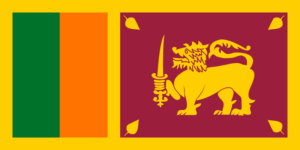 Special Task Force
Special Task Force
The Special Task Force (STF) (Sinhala: විෙශ්ෂ කාර්ය බළකාය) is an elite special forces unit of the Sri Lanka Police specializing in Counter-Terrorist and Counter-Insurgency operations. It was formed in 1983 not as a military force but rather as a highly-specialised police unit. The STF heads Counter-Terrorist missions and – as the most highly trained police organisation in Sri Lanka – it would be the lead unit whenever law enforcement forces engaged the Tamil Tigers (LTTE). The STF is mostly stationed in the Eastern Province of Sri Lanka where the LTTE was wiped out. Some small number of units have placed in Mannar District and Vavuniya District. Other units are based in Colombo and provide VIP security. The STF is internationally recognized for its expertise in these areas and it is often invited to assist foreign law enforcement agencies with planning major events such as the 2008 Beijing Olympics and in dealing with possible terrorist threats.
History Following the insurrection in Sri Lanka in 1971, in which many Police Stations were targeted by JVP insurgents, there were suggestions to train and equip the Police for duties above normal Police functions. However, nothing was done until 1983 when the outbreak of violence convinced the government to form a special Counter Terrorist and Counter Insurgency police force called the Special Task Force.
Formation When the Special Task Force (STF) was formed in 1983, it comprised mainly of existing policemen. Trained by the Sri Lankan Army in the handling of Infantry weapons and were given basic training in Jungle warfare, They deeply resemble a para-military organisation and later separate training facilities for the Special Task Force have been established in Kalutara, 96 kilometers south of Colombo. The first platoons formed were deployed in the North of Sri Lanka to provide additional support for Police Stations and to stem the LTTE separatists.
The STF was enhanced considerably in 1983 when former British Special Air Service (SAS) crack teams were brought in to provide specialized training in all aspects of Counter Terrorism and Counter insurgency operations. August 11, 1984, that the Israel Internal Security Agency Shin Beth was involved in the training of the Sri Lankan armed forces. Many officers belonging to Israel were also involved in the training of the Sri Lankan soldiers in Colombo.
Recently, the STF has received from Indonesia P2 APCs made by Sentra Surya Ekajaya to help the unit conduct their counter insurgency operations against the LTTE.
Operations
By 1987, heavily involved in the Sri Lankan civil war, the STF was in control of the area from Kiran to Potuvil in the Batticaloa Division. The STF was deployed in Company formation into 15 separate camps. When the Indian Peace Keeping Force was moved into the Batticaloa in 1987 as part of the ongoing peace process, the STF was in complete control of Batticoloa, and had restored a level of normalcy to the area. From 1983 to 1987 when the STF was in control over Batticoloa not a single STF camp had come under attack from the LTTE.
Operation Niyathai Jaya (Definite Victory)
In its first major operation since the signing of the ceasefire agreement in 2002, Special Task Force troops launched a limited offensive named “Definite Victory” (In Sinhala: නියතයිි ජය) on January 4, 2007 against LTTE rebels in the Kanchikudichcharu and Thoppigala south regions of the Ampara District, as a reaction to the child abductions in Bakmitiyawa, Ampara and abduction of two teachers and 23 Tamil children in December 2006 while they were returning from extra classes to their homes.
As a result of this offensive, the elite police commandos were able to overrun more than fifteen rebel camps including the Stanly Base, which was the main LTTE camp in the Ampara District and a regional intelligence and supply camp of the LTTE, Bagayadi Base, where local and foreign foodstuffs and sanitary material was stored, Janak Base, which made clothing identical to Sri Lanka Army and Special Task Force uniforms, Jeewan Base, which was another supply camp from which the STF was able to recover four vehicles and the Diana Base where LTTE leaders meet. This camp was furnished with luxury items which were denied to the ordinary LTTE cadres.
After the fall of Stanly Base, STF troops were able to find an explosive laden truck and a motor cycle that the rebels were planning to use to carry out suicide attacks in the capital of Colombo. And it is also reported that LTTE was housing a large number of child soldiers conscripted by them in this camp. Other than that, STF troops were able to recover a large quantity of arms and ammunition, coffins, large number of anti-personnel mines, vehicles, satellite and radio receivers, global positioning systems, power generators, boats with name and logo of the Non Governmental Organization “Save the Children”, tents with the logo of “UNHCR” and a fully equipped hospital donated to the militants by a Dutch INGO named ZOA Refugee Care. This NGO donated hospital is named by the tigers as Thileepan memorial hospital. STF also said that they also found a water tanker truck donated by, the Tamil Rehabilitation Organization (TRO) which is a front organization of the LTTE, who collect funds especially in the United States and Canada purportedly for civilians, but actually for the terrorist group. However, aid workers argue that the supplies must have been taken after they evacuated their office due to heavy fighting. Jeevan Thiagarajah, the head of the Consortium for Humanitarian Agencies, has stated that the matter is simply a misunderstanding.
As a result of this mission STF troops able to kill four rebels and the STF commented that the militants were fleeing from the area without retaliating against their troops.
Criticism The Special Task Force has been accused of various human rights abuses including extrajudicial killings and involvement in the disappearance of individuals.
According to a United Nations commissioned study conducted in 1997, the STF was the arresting agency in 5% of the 1219 reported cases of disappearances in the Batticaloa district in North Eastern Province between 1988 and 1996. Additionally, after a visit to Sri Lanka from 24 August to 5 September in the same year, UN Special Rapporteur Bacre Waly Ndiaye reported the existence of allegations that individuals had died “while in the custody of the Special Task Force of Sri Lanka in Colombo”
At least two incidents of extrajudicial killings involving members of the STF have also been noted by the Sri Lankan government or outside observers. Following the newest round of fighting between the government and the LTTE starting in April 1994, the mutilated bodies of between 21 and 31 Tamil males were discovered in rivers and lakes near Colombo. On August 17, 10 STF officers (and 15 others) were charged with committing the murders, which allegedly took place at the STF headquarters in Colombo. In addition, at least 17 extrajudicial killings were carried out by Sri Lankan security forces (including the STF) in Eastern Province in retaliation for LTTE attacks. Human rights monitors “determined” the deceased to be “civilians”, but security forces maintained that they were LTTE members.
 Arystan Special Task Force
Arystan Special Task Force
Kazakhstan: Authorities Insist Personal Enmity Behind Sarsenbaev’s Murder
February 27, 2006
By Gulnoza Saidazimova
Supporters gather at Sarsenbaev’s funeral on 15 February (RFE/RL)Kazakh authorities announced today that Erzhan Utembaev masterminded the killing of opposition leader Altynbek Sarsenbaev two weeks ago — citing “personal enmity” as a reason behind the murder. Utembaev, chief of administration for the Kazakh Senate, was arrested last week. The announcement comes after thousands of opposition supporters marched in Almaty on 26 February in memory of Sarsenbaev and other victims of what they call the current regime’s “political terror” and demanded that those responsible for the murder be brought to justice. The opposition as well as some analysts have cast doubt over the conclusions of the initial official investigation.
PRAGUE, 27 February 2006 (RFE/RL) — Kazakh Interior Minister Baurzhan Mukhamedzhanov told journalists in Astana today that Erzhan Utembaev, chief of the Kazakh Senate’s administration, planned the slaying of Altynbek Sarsenbaev.
Angry Over Article? Mukhamedzhanov said the motive for the killing was a “long-lasting personal enmity” between the two men. “The person who ordered [the killing] was the former head of the Senate administration [Erzhan Utembaev],” he said. “After Sarsenbaev published an article giving a negative characterization of [Utembaev] in one of the national newspapers, their relations deteriorated rapidly. After the publication of that article, Erzhan Utembaev’s career, in his own words, went downhill. Blaming that on Sarsenbaev, he nurtured the idea of taking revenge on him for a long time.” “The problem is how were all those confessions made by those who allegedly now say that they were involved in the murder? Unfortunately, [in Kazakhstan], those who confess to murder often have nothing to do with it. I am afraid we are seeing that practice in this case.”
Sarsenbaev, a former Information Minister and once the Kazakh ambassador to Russia, joined the opposition in 2003 and was one of the leaders of the Naghyz Ak Zhol (True Bright Path) opposition party. He was kidnapped on 11 February and was found shot dead in the Almaty outskirts two days later with his bodyguard and his driver. On 20 February, five agents of Arystan (Lion), the Kazakh national security service’s (KNB) elite unit, were arrested for the killing and allegedly confessed to kidnapping Sarsenbaev and his aides.
Security Service Involvement KNB chief Nartay Dutbaev resigned on 21 February following the news about the arrests. Utembaev was arrested the next day. Authorities said he ordered the kidnapping and murder of Sarsenbaev. Mukhamedzhanov also said today that Rustam Ibragimov — a former Arystan officer — organized and oversaw the operation while the five other current officers carried out the murder. He said the two have been interrogated and added that Utembaev confessed to taking a $60,000 bank loan to pay for the contract killing.
Opposition Not Buying It The announcement comes after numerous calls from the opposition for a fair investigation and one day after a large protest in Almaty. The opposition has insisted that Sarsenbaev’s murder was politically motivated and it has formed a public committee to conduct an independent probe into the murder. Today, dozens of protesters picketed the Almaty City Interior Affairs Department demanding greater transparency in the investigation of Sarsenbaev’s killing. Analysts also express doubts that personal enmity led to Sarsenbaev’s killing. They say today’s announcement from the country’s interior minister makes it clear how Kazakh authorities want to interpret the murder.
Second Killing Since November Sarsenbaev was the second opposition figure to die under suspicious circumstances in the last three months.
In mid-November, prominent opposition member Zamanbek Nurkadilov’s body was found in his Almaty villa with three gunshot wounds. An official investigation concluded that Nurkadilov had committed suicide. The opposition ruled out this conclusion, arguing that Nurkadilov would not be able to shoot himself twice in the chest and once in the head. The opposition says political reasons are behind both deaths. (RFE/RL’s Kazakh Service contributed to this report.)
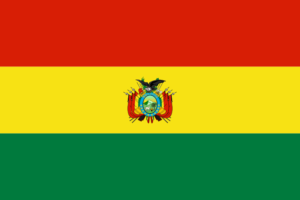 Delta Group
Delta Group
April 28, 2009 Tuesday Late Edition – FinalPlot Foiled? In Bolivia, Truth Is Elusive
BYLINE: By SIMON ROMERO; Andres Schipani contributed reporting from La Paz, Bolivia.
SECTION: Section A; Column 0; Foreign Desk; Pg. 5
LENGTH: 1120 words
DATELINE: CARACAS, Venezuela
Wielding assault rifles, the members of Delta Group, an elite Bolivian police unit, quietly crept up the stairs to the fourth floor of the Hotel Las Americas. It was 4 a.m. on April 16 in Santa Cruz, the city in the lowlands of Bolivia that is a bastion of opposition to that nation’s president, Evo Morales. Then they did their work.
Within minutes, they shot dead three men: Michael Dwyer, 24, of Ireland; Arpad Magyarosi, 39, a Romanian of Hungarian descent; and Eduardo Rozsa Flores, 49, a Bolivian with Hungarian and Croatian passports and a nebulous past as a leader of foreigners fighting for Croatia during the breakup of Yugoslavia.
As the bullet-riddled bodies were shown on national television, the authorities claimed to have foiled a plot to kill Mr. Morales, a former coca grower reviled by Santa Cruz’s light-skinned elite. Soon after the raid, security forces found a cache of explosives and guns that they said were linked to the dead men.
”These terrorists were connected to an ideology of the extreme fascist right,” said Alvaro Garcia Linera, a former Marxist guerrilla who is Bolivia’s vice president.
But the episode, with its dash of Balkan intrigue, remains far from an open-and-shut case of right versus left.
Instead, it falls somewhere in that gray area of Bolivian politics, in which Mr. Morales’s claims of destabilization plots, now a regular feature of his government, and his opponents’ counterclaims that such plots are shams contribute to growing tensions between the central government and the rebellious lowlands.
”If this weren’t such a serious matter, it would make a great screenplay, tragedy and farce all wrapped together,” said Jim Shultz, a political analyst in Cochabamba, in central Bolivia.
In a move that angered political leaders in Santa Cruz, the central government last week ordered more than a thousand troops to the region. Juan Ramon Quintana, a senior aide to Mr. Morales, said the decision was made partly because of a concern over ”the presence of terrorists that are a potential threat to the security of the Bolivian state.”
Meanwhile, the killings have raised a raft of nettlesome questions. Who backed such a group? How did officials detect them? Why did Mr. Morales send the police all the way from the capital, La Paz, to deal with them? And exactly what was a man like Mr. Rozsa Flores, at turns a poet and a war correspondent before his foray into the Balkan killing fields, doing back in Santa Cruz?
Indeed, the mystery of the case revolves largely around this enigmatic figure, believed to be the group’s leader.
He left Bolivia as a teenager, going with his parents into exile in Chile before moving to Hungary, the birthplace of his father, an emigrant of Jewish origin. In Budapest, Mr. Rozsa Flores said he came into contact with Ilich Ramirez Sanchez, the Venezuelan terrorist known as Carlos the Jackal, while studying linguistics and literature, according to published interviews.
Finding work as a correspondent for a Spanish newspaper covering the breakup of Yugoslavia, Mr. Rozsa Flores abandoned journalistic objectivity and took sides. He commanded volunteers fighting for Croatia in the early 1990s, but his battlefield experience was marred by claims that he oversaw the murder of a Briton and a Swiss citizen.
”He lived an overcrowded life, full of events, locations, people, gossip, good and bad legends,” said Ibolya Fekete, a Hungarian director who made a 2001 film, ”Chico,” based on Mr. Rozsa Flores’s life. ”He never fit in anywhere.”
Returning to Hungary after the war, Mr. Rozsa Flores converted to Islam, a shift from his earlier association with Opus Dei, the conservative Roman Catholic group. And he found a new political obsession, explaining in a television interview last year with a Hungarian journalist that he was moving to Bolivia to organize a militia.
”There is a need for weapons,” he said in the interview, which was broadcast for the first time in Hungary last week after his killing, ”so it isn’t about the boys marching in the streets with flags and bamboo sticks.”
Mr. Rozsa Flores went further in the interview, saying his goal was not toppling Mr. Morales, but achieving autonomy for Santa Cruz, Bolivia’s wealthiest department, or province. Envisioning a clash with La Paz over this issue, he nonchalantly described his goal as ”declaring independence and creating a new country.”
Over the weekend, a prosecutor presented a video recorded on a cellphone, without clear audio, in which he said Mr. Rozsa Flores had discussed a plan to kill Mr. Morales on a recent trip to Lake Titicaca.
Such assertions fit well into the way Mr. Morales’s government portrays Santa Cruz: as a region where powerful industrialists and bankers, some of them descendants of Croatian immigrants, want to secede from Bolivia in a rupture inspired by Yugoslavia’s disintegration.
But while Mr. Morales has described the men killed in Santa Cruz as part of a ”tentacle of a structure” intent on killing him and other senior officials named in a list obtained by his government, missteps by officials in describing their handling of the group have led to further questions about the men and what they were doing in Santa Cruz.
Mr. Garcia Linera, the vice president, at first said the three were killed in a 30-minute gunfight, but an insurance report filed for the hotel and obtained by La Razon, a newspaper, apparently found no signs of an exchange of gunfire. Two men taken captive at the hotel, Elod Toazo, a Hungarian, and Mario Tadik, a Bolivian, seem to have surrendered without a fight.
”What happened was the killing of three people who were sleeping, which means murder,” said Oscar Ortiz, president of Bolivia’s Senate and a top opponent of Mr. Morales.
Alfredo Rada, a senior minister, made things worse when he went on television with images of men in Santa Cruz clasping weapons, claiming they were linked to those killed. But the men in the photos, lifted from a Facebook page, debunked the claim by explaining that they practiced ”airsoft,” a game in which participants fire at one another with pellet guns.
The case is fueling conspiracy theories of every stripe, but some secrets were taken to the grave by Mr. Rozsa Flores and his two comrades in arms.
In his interview last September in Hungary, he speculated that Mr. Morales’s intelligence service knew about him, and he also touched on the possibility that he might meet his death in Bolivia.
”I will now go to my home country, my homeland; if something happens to me there, then what?” he said. ”Firstly, it was my fate; secondly, it happens to me in the best place possible.
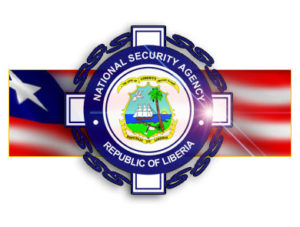 National Security Agency Operation Directorate
National Security Agency Operation Directorate
Africa News
December 13, 2007 Thursday
Liberia;
Coup Plot Suspect Stuns With Testimony
BYLINE: The Analyst
LENGTH: 842 words
A key defendant in the ongoing treason trial yesterday stunned the nation when he testified in open court that the Liberian government had wanted him to implicate certain opposition politicians.Taking the witness’ stand yesterday at Criminal Court-‘A’ on Capitol Hill, Temple of Justice in Monrovia, the relaxed and cautious retired Armed Forces of Liberia (AFL), Col. Andrew Dorbor told the court that the Ellen-led government through the National Security Agency (NSA), had listed top Liberian opposition politicians and former Armed Forces of Liberia (AFL) Soldiers for him, while serving as state witness, to implicate them in the alleged coup plot.
Before a crowded court, Col. Dorbor said while in detention at the National Security Agency (NSA), an officer of the agency, whom he recalled James Pearson went to him with a list containing the names of prominent opposition politicians and coerced him to implicate them in the alleged plot.He further revealed that the government through the NSA agent told him that through that means, he as a suspect of the coup would gain the passport for his freedom.Dorbor said the idea was that he implicate the opposition leaders and at the same time convincingly testify against them on behalf of the state.
According to Dorbor, the opposition politicians that the government wanted him to implicate in the alleged plot include former House Speaker, Edwin Melvin Snowe, who is representing District #5 of Montserrado County; Liberty Party’s Standard-bearer, Cllr. Charles Walker Brumskine; George Weah, the youthful first partisan of the Congress for Democratic Change (CDC); Cllr. Varney Sherman, standard bearer of the Liberia Action Party (LAP) which later branched with other parties into the Coalition for the Transformation of Liberia (COTOL). Suspect Dorbor further said that the NSA operative requested him to name Henry Boima Fahnbulleh Jr., the Security Advisor of President Sirleaf as one of the masterminds of the alleged coup plot. The key defense witness also said that the government wanted him to implicate Gen. Charles Julu, and one William Gibson as well as former top Armed Forces of Liberia (AFL) soldiers.
Still stunning the court with what observers called “troubling news”, Dorbor, the first defense witness to take the stand, testified that the government also wanted him to name another 31 deactivated AFL soldiers as other coup plotters to oust the Liberian government headed by President Ellen Johnson Sirleaf. Continuing with his revelations of what had taken place during his detention at the NSA, Dorbor indicated that the government not only wanted him to implicate other Liberians as coup plotters, but that he was forced to sign series of documents that had been prepared by NSA investigators.
According to him, a particular document that he was coerced to sign was “a request for protective custody”.”I signed the documents because I was threatened by the NSA investigators, that if I did not sign the documents, I would surely feel the weight. I signed the documents with fear that I could be killed in the NSA cell,” witness Dorbor testified.
 National Intelligence Service
National Intelligence Service
The Advertiser (Australia)
December 20, 2008 Saturday
1 – State Edition
Asia-Pacific Plot to kill Kim, says North Korea
BYLINE: HYUNG-JIN KIM, SEOUL
SECTION: FOREIGN; Pg. 77
LENGTH: 411 words
NORTH Korea has accused South Korea of hiring an agent to track Kim Jong Il and suggested that the man had planned an assassination attempt before his arrest.
The sensational allegation comes amid a serious worsening of relations between the divided Koreas, as well as intense speculation about Mr Kim’s health since he reportedly suffered a stroke and had brain surgery in August.
North Korea’s Ministry of State Security – the nation’s spy agency – identified the arrested man’s family name as Ri and said he was trained by the South to get information about Mr Kim’s movements.
“The organisation sent him speech and acoustic-sensing and pursuit devices for tracking the movement of the top leader and even violent poison in the end,” said the statement, also read on North Korean state television.
It said the “terrorist mission” was ordered by South Korean intelligence “to do harm to the top leader”.
South Korea’s National Intelligence Service said it was checking the claim.
The statement, carried by the North’s official Korean Central News Agency, did not mention Mr Kim by name, but a South Korean Unification Ministry spokesman said the North had previously used such wording to refer to him. He said the Unification Ministry was in no position to confirm the report.
Tensions on the Korean peninsula have run high since the pro-U.S. conservative government of President Lee Myung-bak took office in February with a pledge to take a tough line on the North.
Ties worsened this month after the North restricted traffic at the border, expelled some South Koreans from a joint industrial zone and suspended a tour program to the ancient city of Kaesong.
The North’s statement also said authorities recently arrested unspecified agents who tried to gather soil, water, leaves and dust in its major munitions industrial area to gather information on its nuclear program.
This month, international talks on the North’s nuclear development ended in stalemate over its refusal to put into writing any commitments on inspecting its past atomic activities.
Though it was impossible to verify the North’s espionage claims, the divided states – which fought the 1950-53 Korean War – are known to actively spy on each other and have carried out various plots to assassinate each other’s leaders in the past.
South Korean experts said it was rare for the communist country to issue a statement on an alleged assassination attempt, and were divided over the claim’s authenticity.
Weapons
The Weapons of the Gray Man
Firearms play a key role in the Gray Man. Below are a few that are highlighted throughout the novel.
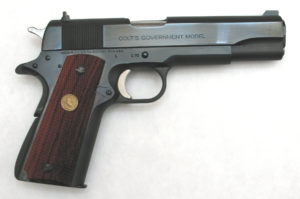 The M1911 is a single-action, semi-automatic, magazine-fed, recoil-operated handgun chambered for the .45 ACP cartridge.[1]It was designed by John M. Browning, and was the standard-issue side arm for the United States armed forces from 1911 to 1985, and is still carried by some U.S. forces. It was widely used in World War I, World War II, the Korean War, and theVietnam War. Its formal designation as of 1940 was Automatic Pistol, Caliber .45, M1911 for the original Model of 1911 orAutomatic Pistol, Caliber .45, M1911A1 for the M1911A1, adopted in 1924. The designation changed to Pistol, Caliber .45, Automatic, M1911A1 in the Vietnam era.[1] In total, the United States procured around 2.7 million M1911 and M1911A1 pistols during its service life.
The M1911 is a single-action, semi-automatic, magazine-fed, recoil-operated handgun chambered for the .45 ACP cartridge.[1]It was designed by John M. Browning, and was the standard-issue side arm for the United States armed forces from 1911 to 1985, and is still carried by some U.S. forces. It was widely used in World War I, World War II, the Korean War, and theVietnam War. Its formal designation as of 1940 was Automatic Pistol, Caliber .45, M1911 for the original Model of 1911 orAutomatic Pistol, Caliber .45, M1911A1 for the M1911A1, adopted in 1924. The designation changed to Pistol, Caliber .45, Automatic, M1911A1 in the Vietnam era.[1] In total, the United States procured around 2.7 million M1911 and M1911A1 pistols during its service life.
The M1911 is the most well-known of John Browning’s designs to use the short recoil principle in its basic design. Besides the pistol being widely copied itself, this operating system rose to become the pre-eminent type of the 20th century and of nearly all modern centerfire pistols.
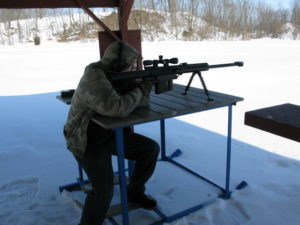 The M82 (also more recently known as the M107) is a recoil-operated, semi-automatic anti-materiel rifle developed by the American Barrett Firearms Manufacturing. A heavy SASR (Special Application Scoped Rifle), it is used by many units and armies around the world. It is also called the “Light Fifty” for its .50 caliber BMG (12.7 mm) chambering. The weapon is found in two variants — the original M82A1 (and A3) and the bullpup M82A2. The M82A2 is no longer manufactured, though the XM500 can be seen as its successor, in that it also employs a bullpup configuration.
The M82 (also more recently known as the M107) is a recoil-operated, semi-automatic anti-materiel rifle developed by the American Barrett Firearms Manufacturing. A heavy SASR (Special Application Scoped Rifle), it is used by many units and armies around the world. It is also called the “Light Fifty” for its .50 caliber BMG (12.7 mm) chambering. The weapon is found in two variants — the original M82A1 (and A3) and the bullpup M82A2. The M82A2 is no longer manufactured, though the XM500 can be seen as its successor, in that it also employs a bullpup configuration.
Photo above courtesy of DARKSOLDIER300
Photos below courtesy of DARKSOLDIER300 and Outpost Armory, Christiana TN
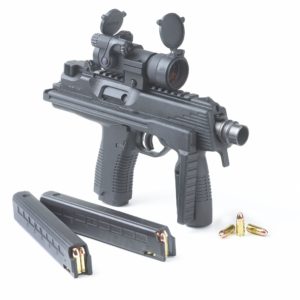 The MP9 is light weight, small size, folding stock and rounded edges makes this a excellent choice for police agencies and militaries which need to have a support weapon carried in the dignitary or VIP protection role, normal patrol, special units, vehicle crew members, aviators or anyone. The only true Tactical Machine Pistol today for professionals that need a lightweight, compact, ambidextrous, and easy to use weapon which will fire the easy to find standard 9mm cartridge.
The MP9 is light weight, small size, folding stock and rounded edges makes this a excellent choice for police agencies and militaries which need to have a support weapon carried in the dignitary or VIP protection role, normal patrol, special units, vehicle crew members, aviators or anyone. The only true Tactical Machine Pistol today for professionals that need a lightweight, compact, ambidextrous, and easy to use weapon which will fire the easy to find standard 9mm cartridge.
The firing system is a simple operation, which means no gas tube to have clogged or locking piece to loose. It is a very clean weapon to shoot; tests of over six thousand rounds can be fired before it effects the functioning. The super light recoil impulse of this weapon is a very easy, comfortable and user friendly weapon to shoot. That is especially appreciated by many agencies, which are hiring a greater number of women and small stature male officers. Your fair shooters will become good shooters and good shooters will become great shooters.
The MP9 is an ambidextrous operator friendly design. The safety, charging handle, sling attachment and magazine release functions are designed to accommodate all users. The operator does not place their hand or finger anywhere near the muzzle of the weapon.
When the MP9 is open with the folded is smaller than a H&K MP5 A3 when the stock is closed. The MP9 is just 30 cm. The quick opening, self-locking stock brings stable firing stock to the overall length to 52 cm. It is the most compact submachine gun in the world. The foregrip is essential to maintain a good sight picture and to keep the operator`s hands and fingers well away from the muzzle of the weapon, effective consistently and safety always!
The wave of the future for all firearms is the use of optics. The MP9 is already prepared for this by having an integrated MIL-STD 1913 Picatinny rail molded right into the top of the receiver. The adjustable ghost ring sight is of a made so that there are no sharp edges to get hung up on clothes or slings but will stay permanent on the weapon.
Photos below courtesy of Bryan Ferreira and Outpost Armory, Christiana TN
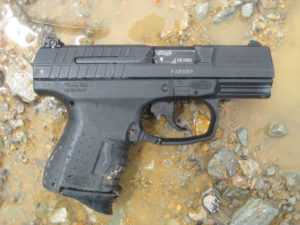 The Walther P99 uses an internal striker as opposed to an external hammer, with a red-painted striker tip that protrudes from rear of the slide when the gun is cocked, as well as a chamber loaded indicator on the right side of the slide. The Walther P99 includes a decocking button, four internal safeties, tool-less takedown, accessory rail, and sights adjustable for both windage and elevation. The Walther P99 also features interchangeable grip backstraps of varying sizes for different users and an ambidextrous magazine release incorporated into the trigger guard.
The Walther P99 uses an internal striker as opposed to an external hammer, with a red-painted striker tip that protrudes from rear of the slide when the gun is cocked, as well as a chamber loaded indicator on the right side of the slide. The Walther P99 includes a decocking button, four internal safeties, tool-less takedown, accessory rail, and sights adjustable for both windage and elevation. The Walther P99 also features interchangeable grip backstraps of varying sizes for different users and an ambidextrous magazine release incorporated into the trigger guard.
Pictured- The Author’s personal weapon
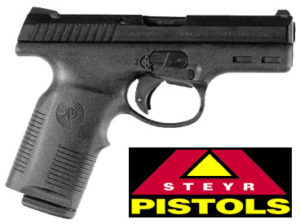 The Steyr M is a series of semi-automatic pistols developed by Steyr Mannlicher GmbH & Co KG of Austria for police services and the civilian shooting market. Design work on the new pistol began in the early 1990s and the final product known as the M9 (adapted to fire the 9x19mm Parabellum cartridge) was officially unveiled in the spring of 1999. The M40 version chambered in .40 S&W was developed shortly after the M9, followed later by the M357 (caliber .357 SIG or 9x22mm) and two compact variants of the M9 and M40 designated the S9 and S40 respectively. These pistols were developed primarily for concealed carry and have a shortened barrel, slide, smaller frame and a reduced magazine capacity.
The Steyr M is a series of semi-automatic pistols developed by Steyr Mannlicher GmbH & Co KG of Austria for police services and the civilian shooting market. Design work on the new pistol began in the early 1990s and the final product known as the M9 (adapted to fire the 9x19mm Parabellum cartridge) was officially unveiled in the spring of 1999. The M40 version chambered in .40 S&W was developed shortly after the M9, followed later by the M357 (caliber .357 SIG or 9x22mm) and two compact variants of the M9 and M40 designated the S9 and S40 respectively. These pistols were developed primarily for concealed carry and have a shortened barrel, slide, smaller frame and a reduced magazine capacity.
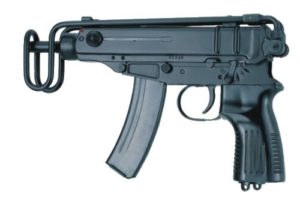 The Škorpion vz. 61 is a Czechoslovakian 7.65 mm submachine gun (often classified as a machine pistol), developed in the 1950s by Miroslav Rybář (1924–1970) and produced under the official designation Samopal vzor 61 (“submachine gun model 1961”) by the Česká Zbrojovka arms factory in Uherský Brod. Although it was developed for use with security forces, the weapon was also accepted into service with the Czechoslovak Army, as a personal sidearm for lower-ranking army staff, vehicle drivers, armored vehicle personnel and special forces. Currently the weapon is in use with the armed forces of the Czech Republic, Slovakia, Angola, Croatia, Egypt, Iraq, Libya, Mozambique and Uganda. It features a synthetic pistol grip compared to the original version.
The Škorpion vz. 61 is a Czechoslovakian 7.65 mm submachine gun (often classified as a machine pistol), developed in the 1950s by Miroslav Rybář (1924–1970) and produced under the official designation Samopal vzor 61 (“submachine gun model 1961”) by the Česká Zbrojovka arms factory in Uherský Brod. Although it was developed for use with security forces, the weapon was also accepted into service with the Czechoslovak Army, as a personal sidearm for lower-ranking army staff, vehicle drivers, armored vehicle personnel and special forces. Currently the weapon is in use with the armed forces of the Czech Republic, Slovakia, Angola, Croatia, Egypt, Iraq, Libya, Mozambique and Uganda. It features a synthetic pistol grip compared to the original version.
The Škorpion uses the 7.65x17mm Browning SR (.32 ACP) pistol cartridge, which was the standard service cartridge of the Czechoslovak security forces. It is a select-fire, straight blowback-operated weapon that fires from the closed bolt position. The cartridge used produces a very low recoil impulse and this enables simple unlocked blowback operation to be employed; there is no delay mechanism and the cartridge is supported only by the inertia of the bolt and the strength of the return springs. When fired, gas pressure drives the case back in the chamber against the resistance provided by the weight of the bolt and its two recoil springs. The bolt travels back, extracting the empty case which is then ejected straight upwards through a port in the receiver housing top cover. The Škorpion’s compact dimensions were achieved by using a telescopic bolt assembly that wraps around a considerable portion of the barrel. The weapon features a spring-loaded casing extractor, installed inside the bolt head and a fixed, double ejector, which is a protrusion in the weapon’s frame.
 The MP7 is a German submachine gun manufactured by Heckler & Koch (H&K) and chambered for the 4.6x30mm cartridge. It was designed in conjunction with the new cartridge to meet NATO requirements published in 1989 calling for a personal defense weapon (PDW) class firearm with a greater ability to defeat body armor than current weapons, which are limited due to the use of conventional pistol cartridges. The MP7 went into production in 2001. The weapon has been revised since its introduction and the current production version is the MP7A1 (see Variants).
The MP7 is a German submachine gun manufactured by Heckler & Koch (H&K) and chambered for the 4.6x30mm cartridge. It was designed in conjunction with the new cartridge to meet NATO requirements published in 1989 calling for a personal defense weapon (PDW) class firearm with a greater ability to defeat body armor than current weapons, which are limited due to the use of conventional pistol cartridges. The MP7 went into production in 2001. The weapon has been revised since its introduction and the current production version is the MP7A1 (see Variants).
The MP7 essentially operates like a scaled-down assault rifle, with the same action as HK’s G36. It fires a specially designed, armor-piercing round with a muzzle velocity nearly as high as that of the 5.56x45mm NATO cartridge used by many modern rifles. This ammunition is unique among submachine guns in that the bullet is made almost entirely of a hardened steel penetrator instead of softer brass or lead. The ammunition is virtually exclusive to the gun (save for the H&K UCP and a planned variant of the Brügger & Thomet MP-9) and also offers low recoil. The round also has a small diameter (it can almost be described as a scaled down .223 Remington), allowing for high capacity in a very small magazine.
The weapon allows a conventional 20-round or 40-round box magazine to be fit within the pistol grip (the former being comparable in size to a 15-round 9 mm magazine, while the latter compares to a 30-round 9 mm magazine). The weapon features an ambidextrous fire-select lever and rear cocking grip. It has an extendable stock and a folding front grip; it can be fired either one-handed or two-handed. It is compact and light using polymers in its construction.
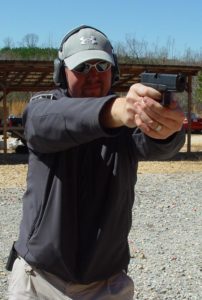 Effectively a reduced-size Glock 17, called the “Compact” by the manufacturer. It was first produced in 1988, primarily for military and law enforcement. The Glock 19 has a barrel and pistol grip that are shorter by approx. 12 mm (0.5 in) compared to the Glock 17 and uses a 15-round magazine (the pistol remains compatible with standard and high-capacity factory magazines). To preserve the operational reliability of the short recoil system, the slide’s mass was kept the same. With the exception of the slide, frame, barrel, locking block, recoil spring, guide rod, and slide lock spring, all of the other components are interchangeable between the models 17 and 19.
Effectively a reduced-size Glock 17, called the “Compact” by the manufacturer. It was first produced in 1988, primarily for military and law enforcement. The Glock 19 has a barrel and pistol grip that are shorter by approx. 12 mm (0.5 in) compared to the Glock 17 and uses a 15-round magazine (the pistol remains compatible with standard and high-capacity factory magazines). To preserve the operational reliability of the short recoil system, the slide’s mass was kept the same. With the exception of the slide, frame, barrel, locking block, recoil spring, guide rod, and slide lock spring, all of the other components are interchangeable between the models 17 and 19.
Pictured- Phillip “Tactical Preacher” Martin and his G-19. (Photo by James Yeager)
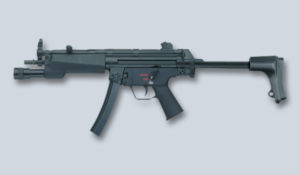 The MP5 (short for Maschinenpistole 5 or “machine pistol model 5”) is a 9mm submachine gun of German design, developed in the 1960s by a team of engineers from the West German small arms manufacturer Heckler & Koch GmbH (H&K) of Oberndorf am Neckar. The company, encouraged by the success of the G3 automatic rifle, developed a family of small arms consisting of four types of firearms (all based on a common G3 design layout and operating principle), where the first type was chambered in 7.62x51mm NATO, the second—using the 7.62x39mm M43 round, third—the intermediate 5.56x45mm NATO caliber and the fourth type—chambering the 9x19mm Parabellum pistol cartridge. The MP5 was created within the fourth group of firearms and was initially known as the HK54.
The MP5 (short for Maschinenpistole 5 or “machine pistol model 5”) is a 9mm submachine gun of German design, developed in the 1960s by a team of engineers from the West German small arms manufacturer Heckler & Koch GmbH (H&K) of Oberndorf am Neckar. The company, encouraged by the success of the G3 automatic rifle, developed a family of small arms consisting of four types of firearms (all based on a common G3 design layout and operating principle), where the first type was chambered in 7.62x51mm NATO, the second—using the 7.62x39mm M43 round, third—the intermediate 5.56x45mm NATO caliber and the fourth type—chambering the 9x19mm Parabellum pistol cartridge. The MP5 was created within the fourth group of firearms and was initially known as the HK54.
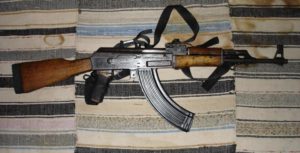 The main advantages of the Kalashnikov rifle are its simple design, fairly compact size and adaptation to mass production. It is inexpensive to manufacture, and easy to clean and maintain; its ruggedness and reliability are legendary. The AK-47 was initially designed for ease of operation and repair by glove-wearing Soviet soldiers in Arctic conditions. The large gas piston, generous clearances between moving parts, and tapered cartridge case design allow the gun to endure large amounts of foreign matter and fouling without failing to cycle. This reliability comes at the cost of accuracy, as the looser tolerances do not allow for precision and consistency. Reflecting Soviet infantry doctrine of its time, the rifle is meant to be part of massed infantry fire, not long range engagements. The average service life of an AK-47 is 20 to 40 years depending on the conditions to which it has been exposed.
The main advantages of the Kalashnikov rifle are its simple design, fairly compact size and adaptation to mass production. It is inexpensive to manufacture, and easy to clean and maintain; its ruggedness and reliability are legendary. The AK-47 was initially designed for ease of operation and repair by glove-wearing Soviet soldiers in Arctic conditions. The large gas piston, generous clearances between moving parts, and tapered cartridge case design allow the gun to endure large amounts of foreign matter and fouling without failing to cycle. This reliability comes at the cost of accuracy, as the looser tolerances do not allow for precision and consistency. Reflecting Soviet infantry doctrine of its time, the rifle is meant to be part of massed infantry fire, not long range engagements. The average service life of an AK-47 is 20 to 40 years depending on the conditions to which it has been exposed.
To fire, the operator inserts a loaded magazine, moves the selector lever to the lowest position, pulls back and releases the charging handle, aims, and then pulls the trigger. In this setting, the firearm fires only once (semi-automatic), requiring the trigger to be released and depressed again for the next shot. With the selector in the middle position (full-automatic), the rifle continues to fire, automatically cycling fresh rounds into the chamber, until the magazine is exhausted or pressure is released from the trigger. As each bullet travels through the barrel, a portion of the gases expanding behind it is diverted into the gas tube above the barrel, where it impacts the gas piston. The piston, in turn, is driven backward, pushing the bolt carrier, which causes the bolt to move backwards, ejecting the spent round, and chambering a new round when the recoil spring pushes it back.
The author training with the AK
Picture courtesy of Bryan Ferreira
 AR-15 (for Armalite model 15) is the common name for the widely-owned semi-automatic rifle which soon afterwards became the fully automatic M16 and M4 carbine assault rifles, which are currently in use by the United States military. AR-15 was the original name for what became the militarily designated M16, the assault rifle first used by the U.S. in the Vietnam War. The name AR-15 is now used almost exclusively to refer to the semi-automatic (commercially available) civilian version(s) of the M16 and M4 assault rifles.All standard AR-15 rifles accept detachable magazines of widely varying capacities, and have a pistol grip that protrudes beneath the stock.
AR-15 (for Armalite model 15) is the common name for the widely-owned semi-automatic rifle which soon afterwards became the fully automatic M16 and M4 carbine assault rifles, which are currently in use by the United States military. AR-15 was the original name for what became the militarily designated M16, the assault rifle first used by the U.S. in the Vietnam War. The name AR-15 is now used almost exclusively to refer to the semi-automatic (commercially available) civilian version(s) of the M16 and M4 assault rifles.All standard AR-15 rifles accept detachable magazines of widely varying capacities, and have a pistol grip that protrudes beneath the stock.
AR-15 rifles are highly configurable and customizable, and are commonly fitted with several accessories, including bipods, bayonet lugs, folding or collapsing butt stocks, threaded barrels for the attachment of a flash suppressor or other accessories, and a Picatinny rail in place of the fore grip for the attachment of vertical grips, flashlights, laser sights, telescopic sights, and other accessories.
Aircraft grade aluminium receiverModular design allows for a variety of accessories and makes repair easierSmall caliber, accurate, high velocity roundSynthetic stock and grips do not warp or splinterFront sight adjustable for elevationRear sight adjustable for windage and elevationWide array of optical devices available in addition to or as replacements of iron sightsA direct impingement gas systemSynthetic pistol grip (regulated in some jurisdictions)Semi-automatic AR-15 for sale to civilians and fully automatic versions for sale to law enforcement and military customers, though nearly identical in appearance, are quite different internally. The hammer and trigger mechanisms are of a slightly different design. The bolt carrier and internal lower receiver of semi-automatic versions are milled differently, so that the firing mechanisms are not interchangeable.
Automatic variants have a three-position rotating selective fire switch, allowing the operator to select between three modes: safe, semi-automatic, and either automatic or three round burst, depending on model. Civilian AR-15 models do not have three-round burst or automatic settings on the fire selector. In semi-automatic only variants, the selector only rotates between safe and semi-automatic.
Pictured- The author’s personal weapon
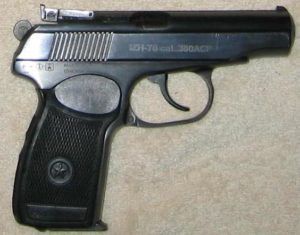 The Makarov PM (Pistol Makarova, muh-KAR-uhv, Russian: Пистолет Макарова) is a semi-automatic pistol designed in the late 1940s, by Nikolay Fyodorovich Makarov, and was the Soviet Union’s standard military side arm from 1951-1991.
The Makarov PM (Pistol Makarova, muh-KAR-uhv, Russian: Пистолет Макарова) is a semi-automatic pistol designed in the late 1940s, by Nikolay Fyodorovich Makarov, and was the Soviet Union’s standard military side arm from 1951-1991.
The Makarov pistol resulted from a design competition for replacing the Tokarev TT-33 semi-automatic pistol. Rather than building a pistol to an existing cartridge, Nikolai Makarov designed a new cartridge, the 9x18mm Makarov. For simplicity and economy, the Makarov pistol was of straight blowback operation, with the 9x18mm cartridge being the most powerful cartridge that its design could safely fire; although the nominal calibre was 9.0mm, the actual bullet was 9.3mm in diameter — shorter and wider and thus incompatible with pistols chambered for 9x19mm Parabellum cartridges. Consequently, Soviet ammunition was unusable in NATO firearms, hence, in war, NATO would be unable to use ammunition from killed or captured Soviet soldiers or from Soviet ammunition dumps.
In 1951, the Pistol of Makarov (PM) was selected because of its simplicity (few moving parts), economy, easy manufacturing, accuracy, and reasonable stopping power. It remained in service with Soviet military and police until the end of the U.S.S.R. in 1991. Today, the Makarov is a popular handgun for concealed carry in the U.S.; variants of the Pistol Makarova remain in production in Russia and Bulgaria, however, in the U.S., Soviet and East German Makarovs are considered Curio & Relic eligible items by the Bureau of Alcohol, Tobacco, Firearms and Explosives, because the countries of manufacture, the U.S.S.R. and the D.D.R. no longer exist.[edit] Design
The Pistol Makarova (PM) is a medium-size, straight blowback action, frame-fixed barrel handgun. In blowback design, the only force holding the slide closed is that of the recoil spring; upon firing, the barrel and slide do not unlock, as do locked-breech design pistols. Blowback designs are simple and more accurate than designs using a recoiling, tilting, or articulated barrel. Blowback-operated pistols are also limited practically by the weight of the slide. The 9x18mm cartridge is the largest, useful cartridge in blowback-operated pistols. The PM is heavy for its size, a desirable attribute in a blowback pistol; the heavy slide provides greater inertia against recoil.
The PM’s notable features are its simplicity and economy of parts; many do more than one task, e.g. the slide stop is the ejector. Similarly, the mainspring powers the hammer and the trigger, while its lower end is the magazine catch. Makarov pistol parts seldom break with normal usage, and are easily replaced using few tools.
The Makarov has a DA/SA (double-action, single-action) operating system. After loading and charging the pistol by pulling back the slide, it can be carried with the hammer down and the safety engaged. To fire, the slide-mounted safety lever is pushed down to the “fire” position, after which the shooter squeezes the trigger to fire the gun. The action of squeezing the trigger for the first shot also cocks the hammer, an action requiring a long, strong squeeze of the trigger. The firing and cycling of the action re-cocks the hammer for subsequent shooting; fired single action with a short, light trigger squeeze. The PM’s operation is semi-automatic, firing as quickly as the shooter can squeeze the trigger. Spent cartridges are ejected to the shooter’s right and rear, some 18-20 feet away. When the safety is engaged,the hammer drops from the cocked position. The safety lever has a notch that blocks the hammer from striking the firing pin. This is the only safe way to lower the hammer.
The PM’s standard magazine holds 8 rounds. After firing the last round, the slide locks open. After inserting a loaded magazine, the slide is closed by activating a lever on the left side of the frame or by withdrawing it to release the slide catch; either action loads a cartridge to the chamber. The pistol is ready to shoot.
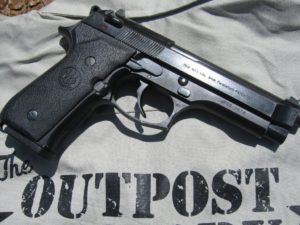 The Beretta pistol mode] 92 has also the following characteristics:
The Beretta pistol mode] 92 has also the following characteristics:
DOUBLE ACTION: which offers the advantages of the revolver. Furthermore, this system allows the possibility of a second quick strike on the same ammunition in the rare instance of misfire which, in view of the high level of quality reached in ammunition today, can practically happen only because of the capsule. The repetition of percussion is sufficient to fire the round.
STAGGERED MAGAZINE: (holds 15 rounds). With the same length as a traditional magazine, it almost doubles the capacity of f ire.
CHAMBER LOADED INDICATOR: when there is a round in the barrel the extractor protrudes laterally showing red. It is therefore possible to check visually (and, at night, to feel) whether there is a round in the barrel without having to retract the slide.
DISASSEMBLING DEVICE: extremely quick and simple. It is designed in such a way as to avoid casual or involuntary disassembly.
BALLISTICS: although depending to a certain extent on the type and the quality of the ammunition and local atmospheric conditions, they are the optima obtainable from a firearm of this size. In normal conditions of use, the average velocity and corresponding kinetic energy of the ammunition fired from this firearm are as follows: V 0.5 = 1280 ft./sec. E 0.5 = 455 ft/bs
Photo courtesy of Outpost Armory, Christiana TN
Journey
The Journey of the Gray Man
All photos by Mark Greaney except “Geneva”, where my computer crashed and I lost all my pics.
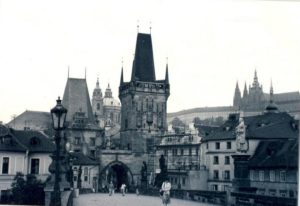 Since the fall of the Iron Curtain, Prague has become one of Europe’s (and the world’s) most popular tourist destinations. It is the sixth most-visited European city after London, Paris, Rome, Madrid and Berlin. Prague suffered considerably less damage during World War II than some other major cities in the region, allowing most of its historic architecture to stay true to form. It contains one of the world’s most pristine and varied collections of architecture, from Art Nouveau to Baroque, Renaissance, Cubist, Gothic, Neo-Classical and ultra-modern.
Since the fall of the Iron Curtain, Prague has become one of Europe’s (and the world’s) most popular tourist destinations. It is the sixth most-visited European city after London, Paris, Rome, Madrid and Berlin. Prague suffered considerably less damage during World War II than some other major cities in the region, allowing most of its historic architecture to stay true to form. It contains one of the world’s most pristine and varied collections of architecture, from Art Nouveau to Baroque, Renaissance, Cubist, Gothic, Neo-Classical and ultra-modern.
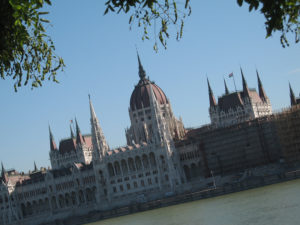 That Budapest – one of the most beautiful cities in the world – has developed where it is, is not down to some historical accident. Take a look at Gellért Hill, right next to the River Danube as it flows majestically through the centre of the modern city. It was precisely the combination of the relative ease of crossing the River here and the natural protection the hill offered against invasion that decided the earliest settlers it was the ideal place to build a town. The Eravisci, a tribe of highly cultured Celts, had already settled at Gellért Hill in the third and fourth centuries B.C. They worked with iron, decorated their earthenware pots and even minted their own coins. Later, the Romans built a settlement at today’s Óbuda. They called it Aquincum and it was an important station along the limes which ran alongside the River Danube.
That Budapest – one of the most beautiful cities in the world – has developed where it is, is not down to some historical accident. Take a look at Gellért Hill, right next to the River Danube as it flows majestically through the centre of the modern city. It was precisely the combination of the relative ease of crossing the River here and the natural protection the hill offered against invasion that decided the earliest settlers it was the ideal place to build a town. The Eravisci, a tribe of highly cultured Celts, had already settled at Gellért Hill in the third and fourth centuries B.C. They worked with iron, decorated their earthenware pots and even minted their own coins. Later, the Romans built a settlement at today’s Óbuda. They called it Aquincum and it was an important station along the limes which ran alongside the River Danube.
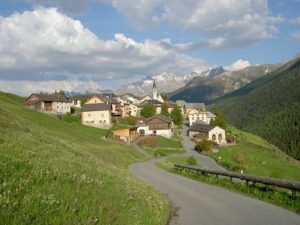 Guarda is a small village located high above the lower part of the valley Engadin (or “Engiadina” in Romansh) in the canton Graubünden at an elevation of 1650 meters above sea level (5413 feet). Once an almost deserted place due to its remote location, it has been revived after most houses have been renovated and sold at attractive prices. Today, Guarda is an attractive place for people seeking quietness and room for outdoor activities. In addition, the village is situated close to the Swiss national park.
Guarda is a small village located high above the lower part of the valley Engadin (or “Engiadina” in Romansh) in the canton Graubünden at an elevation of 1650 meters above sea level (5413 feet). Once an almost deserted place due to its remote location, it has been revived after most houses have been renovated and sold at attractive prices. Today, Guarda is an attractive place for people seeking quietness and room for outdoor activities. In addition, the village is situated close to the Swiss national park.
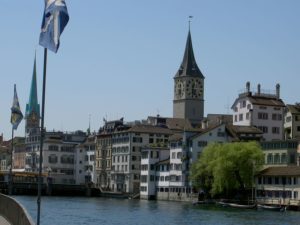 Zurich is the largest city of the Helvetian Confederation (Switzerland) by land area and population. It’s the financial center of Switzerland, houses the stock exchange and the headquarters of a large number of national and international companies. National and international media agencies as well as most of the national TV channel companies are also located here. As Zurich is the central node of the Swiss-wide train network and also runs the biggest and busiest international airport of the country, it generally is the first place for tourists to go to. Because of the city’s close distance to tourist resorts in the Swiss Alps and its mountainous scenery, it often gets referred to as the “portal to the alps”.
Zurich is the largest city of the Helvetian Confederation (Switzerland) by land area and population. It’s the financial center of Switzerland, houses the stock exchange and the headquarters of a large number of national and international companies. National and international media agencies as well as most of the national TV channel companies are also located here. As Zurich is the central node of the Swiss-wide train network and also runs the biggest and busiest international airport of the country, it generally is the first place for tourists to go to. Because of the city’s close distance to tourist resorts in the Swiss Alps and its mountainous scenery, it often gets referred to as the “portal to the alps”.
Contrary to some belief, Zurich is not the capital of Switzerland– that honor falls to Berne. Zurich has long been known for being clean and efficient. Due to this, it has been continuously ranked as the city with the highest living standard world-wide for many years. However, it is only for the last ten years has it truly become a fascinating and worthwhile travel destination. This is mostly thanks to the liberalization of the cultural, party and gastronomy sectors. An increasingly cosmopolitan population has helped, as well, though more button-down Geneva remains Switzerland’s most culturally heterogeneous city.
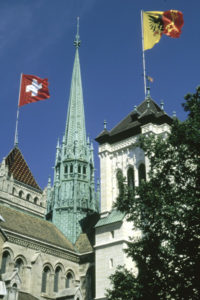 Geneva is the second-most-populous city in Switzerland (after Zürich) and is the most populous city of Romandie (the French-speaking part of Switzerland). Situated where the Rhône River exits Lake Geneva (in French known as Lac Léman), it is the capital of the Republic and Canton of Geneva.
Geneva is the second-most-populous city in Switzerland (after Zürich) and is the most populous city of Romandie (the French-speaking part of Switzerland). Situated where the Rhône River exits Lake Geneva (in French known as Lac Léman), it is the capital of the Republic and Canton of Geneva.
The city proper had a population of 186,825 in June 2008, and the metropolitan area had 812,000 residents, according to a 2007 census. The Geneva metropolitan area extends partly over Switzerland (517,000 inhabitants) and partly over France (293,000 inhabitants).
Geneva is a worldwide centre for diplomacy and international cooperation, and is widely regarded as a global city, mainly because of the presence of numerous international organisations, including the headquarters of many of the agencies of the United Nations and the Red Cross. It is also the place where the Geneva Conventions were signed, which chiefly concern the treatment of wartime non-combatants and prisoners of war.
Geneva has been described as the world’s sixth most important financial centre by the Global Financial Centres Index, ahead of Tokyo, Chicago, Frankfurt and Sydney, and a 2009 survey by Mercer found Geneva to have the third-highest quality of life in the world (narrowly outranked by Zürich). The city has been referred to as the world’s most compact metropolis and the “Peace Capital”.
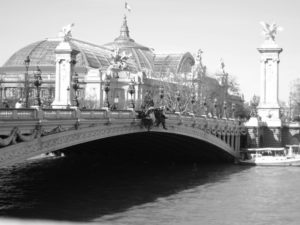 Paris is the capital of France and the country’s largest city. It is situated on the river Seine, in northern France, at the heart of the Île-de-France region. The city of Paris, within its limits largely unchanged since 1860, has an estimated population of 2,167,994 (January 2006), but the Paris aire urbaine (or metropolitan area) has a population of nearly 13 million, and is one of the most populated metropolitan areas in Europe.
Paris is the capital of France and the country’s largest city. It is situated on the river Seine, in northern France, at the heart of the Île-de-France region. The city of Paris, within its limits largely unchanged since 1860, has an estimated population of 2,167,994 (January 2006), but the Paris aire urbaine (or metropolitan area) has a population of nearly 13 million, and is one of the most populated metropolitan areas in Europe.
An important settlement for more than two millennia, Paris is today one of the world’s leading business and cultural centres, and its influence in politics, education, entertainment, media, fashion, science and the arts all contribute to its status as one of the world’s major global cities. According to 2005 estimates, the Paris urban area is Europe’s biggest city economy, and is fifth in the world’s list of cities by GDP.
Paris is one of the most popular tourist destinations in the world, with 45 million tourists every year in the Paris Region, 60% of whom are foreign visitors. There are numerous iconic landmarks among its many attractions, along with world-famous institutions and popular parks.
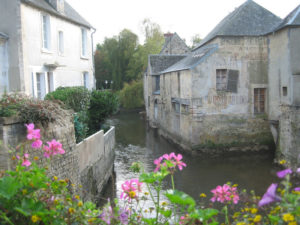 Bayeux (pronounced [bajø]) is a commune in the Calvados department in Normandy in northwestern France.
Bayeux (pronounced [bajø]) is a commune in the Calvados department in Normandy in northwestern France.
Bayeux is located seven kilometers from the coast of La Manche (English Channel) and 30 km north-west of Caen. The city is bisected by the Aure. Bayeaux is the capital of the Bessin, which extends north-west of Calvados.
Bayeux is a major tourist attraction, best known to British and French visitors for the Bayeux tapestry, made to commemorate the Norman conquest of England in 1066. The tapestry is believed to have been woven in England. It is displayed in a museum in the town centre. The large Norman-Romanesque Cathédrale Notre-Dame de Bayeux, consecrated in 1077, was the original home of the tapestry.
Research
Travel Research
Researching the Gray Man took Mark from the Prague underground, through back alleys in Budapest, to Swiss mountain villages, and into elegant chateaux in France. Below are some pictures from his research.
Firearms Research
In order to accurately depict the weapons and tactics used by both the hero and villians in the Gray Man, Mark trained in tactical rifle and pistol craft. Photos from some of the training are below.
Special Thanks to Tactical Response, Camden TN
